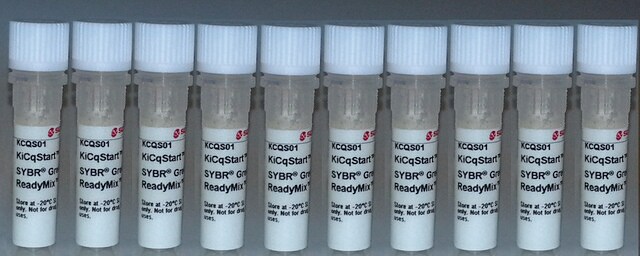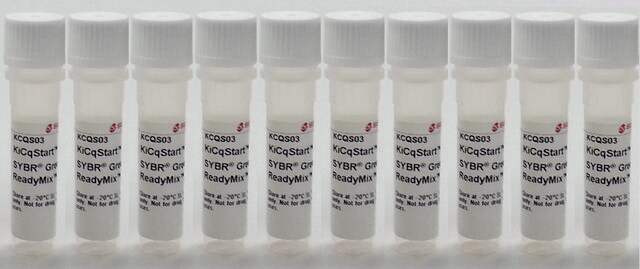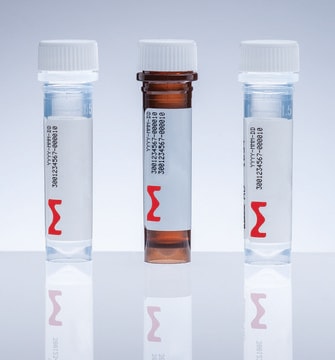KCQS02
KiCqStart® SYBR® Green qPCR ReadyMix™
with ROX™ for ABI instruments
Synonym(s):
qPCR master mix, sybr green qPCR
About This Item
Recommended Products
form
liquid
usage
sufficient for 1250 reactions
sufficient for 250 reactions
sufficient for 5000 reactions
feature
dNTPs included
hotstart
storage condition
protect from light
technique(s)
qPCR: suitable
color
colorless
input
purified DNA
compatibility
for use with ABI 5700
for use with ABI 7000
for use with ABI 7300
for use with ABI 7700
for use with ABI 7900 HT Fast
for use with ABI 7900 HT
for use with ABI 7900
for use with ABI StepOne
for use with ABI StepOnePlus
detection method
SYBR® Green
shipped in
dry ice
storage temp.
−20°C
Looking for similar products? Visit Product Comparison Guide
General description
Highly specific amplification is crucial to successful qPCR with SYBR Green I dye technology because this dye binds to and detects any dsDNA generated during amplification. Hot-Start Taq DNA polymerase is antibody mediated to be inactive prior to the initial PCR denaturation step.
Application
- in the amplification and quantification of cDNA reverse transcribed from RNA extracted from mice brain samples in a 2-step RT-qPCR assay
- to analyze DNA purified by ChIP technique
- to perform gene expression analysis
- in amplification of RNA isolated from hearts of adult TL wild-type fish by quantitative real-time polymerase chain reaction (PCR)
- Gene expression
- DNA quantification
- CHiP
Features and Benefits
- Assay results in as little as 33 minutes
- Highly efficient and sensitive real-time PCR results
- Little/no optimization required
Components
packaging:
250 reactions* = 2 X 1.25 mL tubes
1250 reactions* = 10 X 1.25 mL tubes
5000 reactions* = 1 X 50 mL tube
*number of reactions based on a 20uL volume
Other Notes
KiCqStart SYBR Green qPCR ReadyMix is stable for 1 year when stored in a constant temperature freezer at -20°C, protected from light. For convenience, it may be stored unfrozen at +2 to +8°C for up to 6 months. After thawing, mix thoroughly before using. Repeated freezing and thawing of the product is not recommended. However, the product demonstrated no loss of performance after 20 freeze-thaw cycles or 2 months at +20°C.
Legal Information
recommended
related product
Storage Class Code
12 - Non Combustible Liquids
WGK
WGK 3
Flash Point(F)
Not applicable
Flash Point(C)
Not applicable
Certificates of Analysis (COA)
Search for Certificates of Analysis (COA) by entering the products Lot/Batch Number. Lot and Batch Numbers can be found on a product’s label following the words ‘Lot’ or ‘Batch’.
Already Own This Product?
Find documentation for the products that you have recently purchased in the Document Library.
Customers Also Viewed
Articles
After a traditional PCR has been completed, the PCR/qPCR data analysis is conducted by resolution through an agarose gel or, more recently, through a capillary.
PCR assay guide navigates you through primer validation and other assay optimization factors to ensure high sensitivity and specificity for optimum DNA/ RNA quantification.
The polymerase chain reaction is one of the most widely used techniques in molecular biology. The PCR process consists of three main steps, Denaturation, Annealing & Extension
Protocols
Quantitative PCR protocol using SYBR Green reagents. Procedure supports most qPCR instruments.
Measuring a target quantity relative to one or more stable reference genes using SYBR Green I dye detection is a common application of qPCR. Below is a standard protocol that can be adapted to specific experimental needs.
Analysis of gene expression data requires a stable reference or loading control. This reference is usually one or more reference genes.
Optimization of qPCR conditions is important for the development of a robust assay. The two main approaches are optimization of primer concentration and/or annealing temperatures.
Our team of scientists has experience in all areas of research including Life Science, Material Science, Chemical Synthesis, Chromatography, Analytical and many others.
Contact Technical Service











